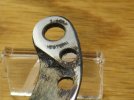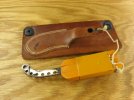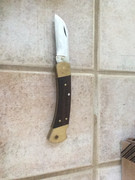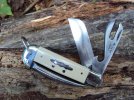I thought perhaps a compare and contrast might be in order. As pictured below:
- Oakedge - left
- Otter-Messer large Anchor knife - center
- Case Whaler (1974) - right
Oakedge Sheepsfoot, Rosewood Worked Back. Made in England. This knife features some really nice file work on the spine and spring, although I believe I recall it also being available without the tooling. The blade is high carbon steel (not stainless), polished. Not a true half stop, but the action does get stiffer around the area where you'd typically expect a half stop. Pretty good snap open and closed. Decent pull. Brass liners and pins. Polished nickel brass bolster.
Otter-Messer Anchor - Made in Germany. This knife is the larger of two available sizes. It also features a high carbon steel blade, but with more of a satin finish. The bolster is also more of a brushed, satin (stainless) finished as compared to the other two knives. I'm finding that to be fairly common with modern, German made knives. The handle is sapeli wood, and is quite dark, nearly black in appearance, similar to ebony. Stainless liners, brass anchor inlay and pins. Features a lanyard, but I believe is also available without the lanyard. Very good snap open and closed. Slightly weaker pull than the Oakedge. Overall, the Otter-Messor is thickest in the handle of the three. In terms of a pure cutting tool, the Otter-Messer Anchor is more substantial than the others.
Case XX Whaler - Made in USA. This is the only of the three not of recent build. This particular knife was made in 1974, but is in very good to excellent condition. Polished stainless blade, bail and bolsters, brass liner, brass pins. The Case has a true half stop, and weakest overall pull of the three, but the overall travel of the blade from closed to open and back, seems the smoothest. The handle is walnut, and is the only one of the three to feature bolsters on both ends. Surprisingly, the Case is the thinnest in the handle of the three. The blade on the Case is a bit more "front leaning" than the other two if you take my meaning.
The Case and Otter-Messer are very nearly identical in blade, handle, and overall size, whereas the Oakedge is a bit shorter all around.







